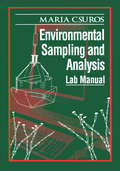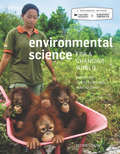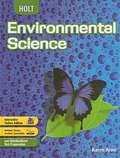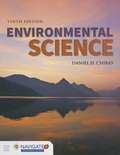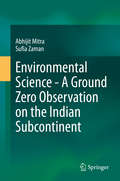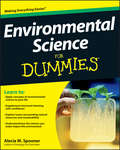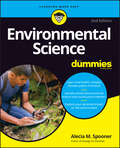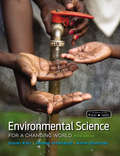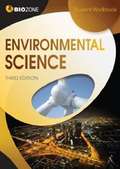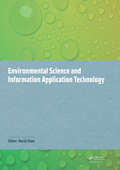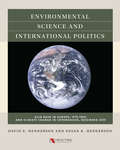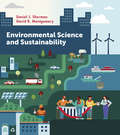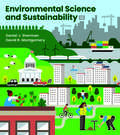- Table View
- List View
Environmental Sampling and Analysis: A Practical Guide
by LawrenceH. KeithThis concise book covers all the critical aspects of environmental sampling and analysis. Extensively peer-reviewed by scientists from the U.S. Environmental Protection Agency and other government agencies, industry and academia, it is packed with practical advice and tips from renowned experts.Planning, sampling, analysis, QA/QC, and reporting are discussed for air, water, solid liquid, and biological samples, with emphasis on the interdependence between sampling and analytical activities. Special requirements for sampling devices, containers, and preservatives are provided with convenient checklists for sampling plans and protocols.New and revised recommendations involving method detection levels, reliable detection levels, and levels of quantitation are discussed in conjunction with laboratory reports and user presentations of data near analytical detection limits.This is a valuable and comprehensive reference book for chemists, technicians, consultants, lawyers, regulators, engineers, quality control officers, news and information managers, teachers, and students.
Environmental Sampling and Analysis: Lab Manual
by Maria CsurosThis manual covers the latest laboratory techniques, state-of-the-art instrumentation, laboratory safety, and quality assurance and quality control requirements. In addition to complete coverage of laboratory techniques, it also provides an introduction to the inorganic nonmetallic constituents in environmental samples, their chemistry, and their control by regulations and standards. Environmental Sampling and Analysis Laboratory Manual is perfect for college and graduate students learning laboratory practices, as well as consultants and regulators who make evaluations and quality control decisions. Anyone performing laboratory procedures in an environmental lab will appreciate this unique and valuable text.
Environmental Sampling for Unknowns
by Kathleen Hess-KosaEnvironmental Sampling for Unknowns covers modern approaches to indoor and outdoor environmental sampling, with an emphasis on identifying unknown substances.
Environmental Science
by D. Dubay A. Lapinski R. R. Schoch A. TweedA textbook on environmental science.
Environmental Science
by Andrew H. Lapinski Anne Tweed Robert M. SchochThe chapters in this book cover the following topics: Studying earth, Ecological interactions, Biomes, People in the global ecosystem, Energy resources, Resources in the biosphere, Managing human impact.
Environmental Science
by Anne Houtman Susan Karr Jeneen InterlandiFollowing real people and real science, Environmental Science for a Changing World provides a unique context for showing students how science works and how to think critically about environmental issues. Chapters don't merely include interesting stories--each chapter is an example of science journalism at its best, combining Scientific American-style writing, layout, and graphics to tell one compelling story that exemplifies important concepts and issues. This approach has proven so effective, that instructors using the book report a dramatic increase in the number of students who read the assignments and come to class ready to participate. This updated new edition features new stories, updated scientific coverage, and enhanced Infographics--the book's signature visual study tool that combines memorable images, step-by-step callouts, and now, questions that foster scientific literacy.
Environmental Science
by Judy Braus Sara St. AntoineThis book covers the environmental sciences. It also focuses on skills that scientists use. These skills include asking questions, making predictions, designing experiments or procedures, collecting and organizing information, calculating data, making decisions, drawing conclusions, and exploring more options.
Environmental Science
by Karen ArmsIn reading Environmental Science, students not only learn a lot about science, they will learn about the complex issues facing our environment. They will explore different points of view and be exposed to a variety of differing opinions.
Environmental Science
by Michael J. PadillaThis hands-on content-rich program enables you to lead your students through explorations of specific concepts within Life, Earth, and Physical Science.
Environmental Science
by Prentice-Hall Staff WithgottTeaching environmental science is much more than just communicating facts and information. It's about engaging and motivating students. It's about helping them to better understand how and why their actions--and those around them--impact the world in which they live. <P><P> Environmental Science: Your World, Your Turn is a new high school program that brings the outside world into the classroom--making the science personal, actionable, and empowering for each student.
Environmental Science (Tenth Edition)
by Daniel D. ChirasProvides a comprehensive, student-friendly introduction to the environmental issues facing society today and offers numerous solutions for how we can create a more sustainable way of life.
Environmental Science (Third Edition)
by Jane L. PersonEnvironmental science covers ecology, atmosphere, water, energy, science and technology.
Environmental Science - A Ground Zero Observation on the Indian Subcontinent: A Ground Zero Observation On The Indian Subcontinent
by Abhijit Mitra Sufia ZamanThis book provides a cross-sectoral, multi-scale assessment of different environmental problems via in-depth studies of the Indian subcontinent. Data collected from different ecosystems forms a strong foundation to explore the topics discussed in this book. The book investigates how mankind is presently under the appalling shadow of pollution, climate change, overpopulation and poverty. The continuing problem of pollution, loss of forests, disposal of solid waste, deterioration of environment, global warming and loss of biodiversity have made nations aware of environmental issues. Many countries are desperately trying to move away from this adverse situation through technological development and policy level approaches. Through a number of case studies the authors provide details of ground level observations of the most environmentally stressed regions in the Indian subcontinent and beyond.
Environmental Science 13th ed
by G. Tyler Miller Scott E. SpoolmanENVIRONMENTAL SCIENCE will inspire and equip you to make a difference for the world. Featuring sustainability as their central theme, authors Tyler Miller and Scott Spoolman emphasize natural capital, natural capital degradation, solutions, trade-offs, and the importance of individuals. As a result, you will learn how nature works, how you interact with it, and how people have sustained'and can continue to sustain'our relationship with the earth by applying nature's lessons to economies and individual lifestyles. Engaging features like "Core Case Studies," "How Would You Vote" questions, and "Thinking About" exercises demonstrate the relevance of issues and encourage critical thinking. This edition has been updated with new learning tools, the latest content, and an enhanced art program.
Environmental Science A Global Concern
by William P. Cunningham Mary Ann Cunningham Barbara Woodworth SaigoColor photos and diagrams illustrate this text for undergraduate students with little or no science background. Material is divided into five sections on environmental science and ecological principles; population, economics, and environmental health; food, land, and biological resources; physical resources; and society and the environment, emphasizing the global environment, a holistic approach, and sustainable development. This third edition contains new boxes on current topics including electromagnetic fields and biotechnology. Annotation c. by Book News, Inc. , Portland, Or.
Environmental Science For AP®
by Andrew Friedland Rick RelyeaEnvironmental Science For AP® Textbook
Environmental Science For Dummies
by Alecia M. SpoonerThe easy way to score high in Environmental ScienceEnvironmental science is a fascinating subject, but some students have a hard time grasping the interrelationships of the natural world and the role that humans play within the environment. Presented in a straightforward format, Environmental Science For Dummies gives you plain-English, easy-to-understand explanations of the concepts and material you'll encounter in your introductory-level course.Here, you get discussions of the earth's natural resources and the problems that arise when resources like air, water, and soil are contaminated by manmade pollutants. Sustainability is also examined, including the latest advancements in recycling and energy production technology. Environmental Science For Dummies is the most accessible book on the market for anyone who needs to get a handle on the topic, whether you're looking to supplement classroom learning or simply interested in learning more about our environment and the problems we face.Presents straightforward information on complex conceptsTracks to a typical introductory level Environmental Science courseServes as an excellent supplement to classroom learningIf you're enrolled in an introductory Environmental Science course or studying for the AP Environmental Science exam, this hands-on, friendly guide has you covered.
Environmental Science For Dummies
by Alecia M. SpoonerAce your environmental science class and get smart about the environment Environmental Science For Dummies is a straightforward guide to the interrelationships of the natural world and the role that humans play in the environment. This book tracks to a typical introductory environmental science curriculum at the college level—and is great as a supplement or study guide for AP Environmental Science, too. Uncover fascinating facts about the earth’s natural resources and the problems that arise when resources like air, water, and soil are contaminated by pollutants. If you’re in need of extra help for a class, considering a career in environmental science, or simply care about our planet and want to learn more about helping the environment, this friendly Dummies resource is a great place to start. The key concepts of environmental science, clearly explained All about the changing climate, including new understanding of methane release in the arctic Earth’s natural resources and the importance of protecting them A new chapter on environmental justice, where issues of poverty and sustainability intersectA solid foundation in environmental science is essential for anyone looking for a career in the field—and is important knowledge for all of us as we work together to build a sustainable future.
Environmental Science For a Changing World (Third Edition)
by Anne Houtman Susan Karr Jeneen Interlandi<P>Following real people and real science, Environmental Science for a Changing World provides a unique context for showing students how science works and how to think critically about environmental issues. Chapters don’t merely include interesting stories they are examples of science journalism at its best, combining Scientific American-style writing, layout, and graphics to tell compelling stories that exemplify important concepts and issues. This approach has proven so effective that instructors using the book report a dramatic increase in the number of students who read the assignments and come to class ready to participate. <P>This updated new edition features new stories, updated scientific coverage, and enhanced Infographics—the book’s signature visual study tool that combines memorable images, step-by-step callouts, and questions that foster scientific literacy. The book is organized into 11 chapters, each consisting of multiple modules focused on different aspects of environmental science, from ecology and evolution, to human interactions with the environment, to land, water, and energy resources. Although each module tells a compelling and relatable story, it is built on a core pedagogy of Guiding Questions that help students extract the scientific concepts that form the basis for the story.
Environmental Science Student Workbook (Third Edition)
by Tracey Greenwood Richard Allan Kent Pryor Lisa Bainbridge-SmithEnvironmental Science introduces students to the Earth's physical and biological systems, and the interactions of humans with these. This revision introduces new content and aligns the workbook to its supporting digital resources. Content developments include updates on the Gulf of Mexico oil spill and the Fukushima Daiichi nuclear disaster, and in-depth coverage of energy extraction issues, pollution, and the wider environmental implications of urban development. The ideal companion to both the APES curriculum and the IB Environmental Systems and Societies.
Environmental Science and Information Application Technology: Proceedings of the 2014 5th International Conference on Environmental Science and Information Application Technology (ESIAT 2014), Hong Kong, November 7-8, 2014
by David ChanEnvironmental Science and Information Application Technology contains selected papers from the 2014 5th International Conference on Environmental Science and Information Application Technology (ESIAT 2014, Hong Kong, 7-8 November 2014). The book covers a wide variety of topics: - Global Environmental Change and Ecosystems Management - Graphic and I
Environmental Science and International Politics: Acid Rain in Europe, 1979-1989, and Climate Change in Copenhagen, 2009
by David E. Henderson Susan K. HendersonEnvironmental Science and International Politics features two reacting games in one volume, immersing students in the complex process of negotiating international treaties to control environmental pollution. The issues are similar in all the modules; environmental justice, national sovereignty, and the inherent uncertainty of the costs and benefits of pollution control. Students also must understand the basic science of each problem and possible solutions. Acid Rain in Europe, 19779-1989 covers the negotiation of the Long Range Transport Pollution treaty. This was the first ever international pollution control treaty and remains at the forefront of addressing European pollution. This game can be used in a variety of ways and to examine either sulfur dioxide pollution, nitrogen oxide pollution, or both. This game includes summaries of a number of relevant technical articles to support student arguments. Students must deal with the limitations of national resources as they decide how much of their limited money to spend.Climate Change in Copenhagen, 2009 covers the negotiations at the Conference of Parties 15 meeting that was attended by a large number of national leaders. The game also includes representatives of non-government organizations and the press. Students wrestle with the need to work within conflicting limits set by their governments.
Environmental Science and Sustainability
by David R. Montgomery Daniel J. ShermanMake environmental science and sustainability personal Environmental Science and Sustainability helps students discover their role in the environment and the impact of their choices. Authors David Montgomery and Daniel Sherman bring scientific and environmental policy expertise to a modern treatment of environmental science; in addition to teaching climate change, sustainability, and resilience, they reveal how our personal decisions affect our planet and our lives. This purchase offers access to the digital ebook only.
Environmental Science and Sustainability (Second Edition)
by David R. Montgomery Daniel J. ShermanMake environmental science personal More than ever, students are thinking about their choices in a changing environment. Environmental Science and Sustainability gives students a scientific understanding of the environment while helping them practice decision-making. The Second Edition now integrates the role environmental justice plays in decisions, and new insights gained from the pandemic and IPCC Sixth Assessment. The Norton Illumine Ebook, InQuizitive, and What Would You Do? decision-making activities build a learning pathway of interactive reading and practice at one low price. This purchase offers access to the digital ebook only.

